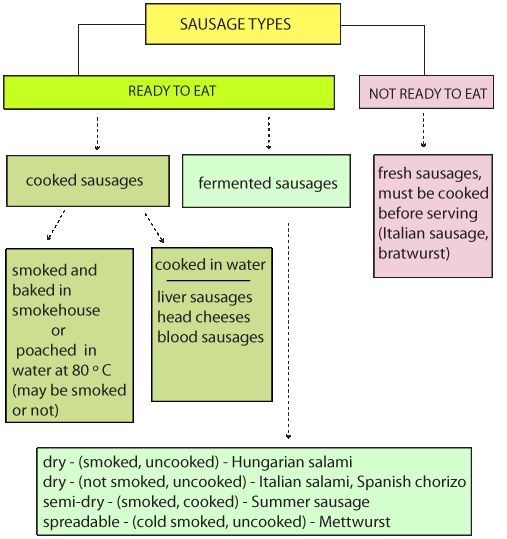Meats and Sausages
Sausage Types
Sausages come in many shapes and different combinations of meat and spices. In some countries, they are classified by the degree of comminution, coarse grind or fine grind sausages, which adds only to confusion. The following American system is straightforward and practical:

Not Ready to Eat Sausages
These are fresh sausages that are made normally from pork, but sometimes also beef or veal. The meat is not cured; sausages must be refrigerated and fully cooked before serving. Polish White Sausage is a fresh sausage that is boiled before serving. An example is German Bratwurst, which is grilled. The South American version, Spanish chorizo, is a fresh sausage fried with eggs for breakfast.
Ready to Eat Sausages
This is the main group of sausages that covers almost every sausage. Except for fermented and air-dried sausages, all sausages that belong to this group are cooked either in hot water or baked in a smokehouse or the oven. Some sausages are hot smoked and cooked, others are not smoked, only cooked.
Special Sausages
This group of sausages covers the following products:
- Liver sausages
- Head cheeses
- Blood sausages
What makes them unique is that meats are cooked in water, stuffed into a casing, and cooked again. They are usually consumed cold. however, blood sausages, in most cases, are fried. Meat for head cheeses and blood sausages is pre-cooked. Liver sausages may be an exception as the liver is added raw or only scalded. Their production is more time-consuming as it requires additional cooking. This secondary cooking is not performed for the product's safety as the meats were already cooked. Take head cheese as an example: cold meats were stuffed into the casing, and the gelatin started to solidify. If left to itself, there might be little binding between meat pieces and gelatin. The secondary heating of the sausage liquifies gelatin, which solidifies and bonds ingredients together upon cooling. This creates a proper bond between meat and gelatin.
These products are very popular in Europe and worldwide except the USA, where only liver sausages can be found in large supermarkets. To purchase head cheese or blood sausage, one must shop in ethnic butcher shops, be it German, Polish, Russian, Irish, or others. These sausages were always made on the farm when the pig was slaughtered. and any meat cuts that would not be used to make regular sausages were incorporated into their production. This fact probably induced many people not to believe those materials were inferior, but nothing could be further from the fact. First, cuts such as pork head meat, snouts, skin, hocks, jowls, tongues, back fat, liver, kidneys, etc., are used for making emulsified sausages like hotdogs and frankfurters. Secondly, they are good meats, and for example, some of them, like pork head meat, are very flavorsome.
A feasible explanation for the lower popularity of these sausages is that manufacturers see less profit in their manufacture as they require cooking meats, separating them from bones, filtering stock, stuffing them in casings, and cooking them again. It requires more space and additional equipment, involves a lot of labor, and the product has to be sold at a price that would justify the investment. That may be harder to accomplish when selling head cheese made from organ meats or blood sausage that incorporates blood plus pieces of fat and bread crumbs. Their shelf-life is much shorter than other sausages, creating problems for supermarkets. These above conclusions do not negate the fact that these are delicious products to eat.
General considerations for making special sausages:
- Pork - all parts are suitable.
- Lean beef - sometimes added to liver sausages. Beef fat should not be added at all.
- Veal - can be successfully used but it is pricey.
- Sheep and goat - may be used, but should be selected from younger animals.
- Wild game - not suitable.
The manufacturing process
Meats are rinsed/soaked in cold water to eliminate traces of blood.
- Meats are simmered below the boiling point for 3-4 hours until they can be separated from bones. As you may cook different-sized sausages in the same vessel, some stirring is required to expose cooked products to uniform temperatures. A wooden spoon with a long handle will perform this duty neatly. The resulting stock should be saved for two reasons:
It is added to the head cheese and forms the jelly.
It is used as a cooking medium. - Meat is separated from bones and cut manually.
- Liver is ground and emulsified. Livers must not be cooked. Back fat should be diced into ⅜” (1 cm) pieces and then boiled for about 30 minutes. Skins should be boiled until soft but not overcooked. Tongues are scalded for a few minutes in hot water to remove the skin and to clean them. Then, they are boiled.
- Meats are mixed with other ingredients. In head cheeses, the meat stock is added.
- Sausages are stuffed loosely with a horn and a ladle.
- Sausages are poached at about 176° F (80° C).
- Sausages are cooled and stored under refrigeration.
Fermented Sausages
Fermented sausages can be classified as:
- Cold smoked and dried but uncooked - Hungarian salami,
- Cold smoked and uncooked - spreadable raw sausages (Mettwurst), very popular in Germany.
- Not smoked, dried and uncooked - Italian salami, Spanish chorizo.
- Hot smoked partially or fully cooked semi-dry sausages (Summer Sausage, Pepperoni, Salami).
- Dry fermented sausages, which are traditionally made slow fermented sausages, are produced at low temperatures and are occasionally smoked with cold smoke. Semi-dry sausages are smoked with hot smoke.
Smoked Sausages
All sausages can be smoked or not. What was once an important preservation step has become a matter of personal preference. If you like the smoky flavor, smoke the sausage; it’s that simple.

















